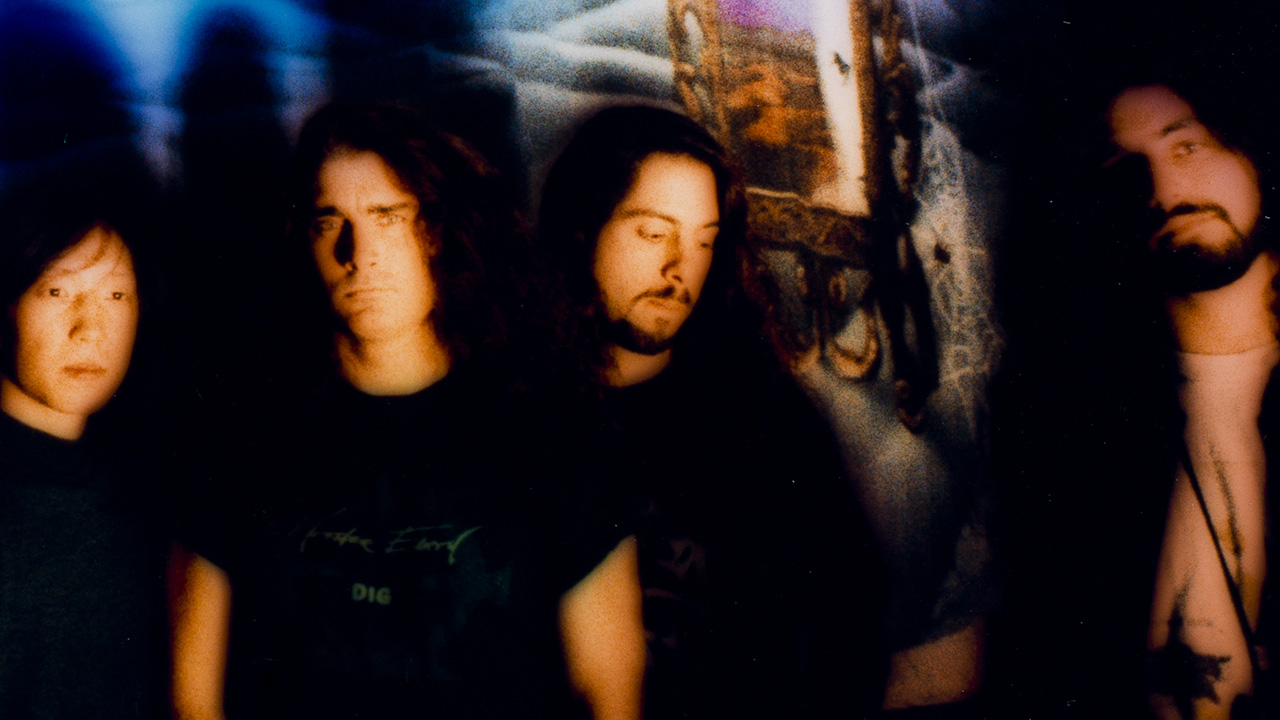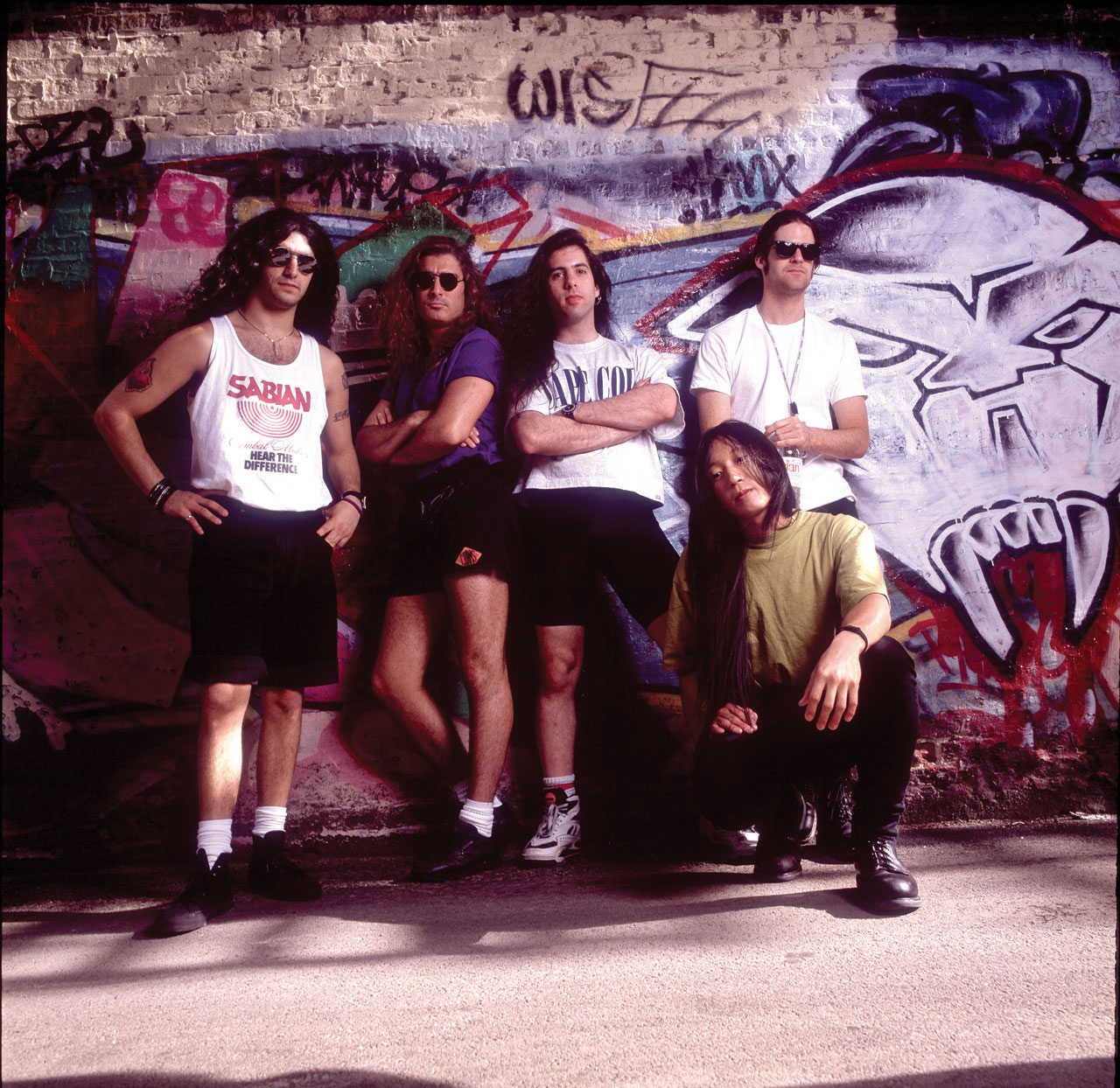“We knew the album would stick out like a sore thumb and we’d have to show real tenacity. But if it wasn’t for Pull Me Under there’s a strong chance we wouldn’t be having this conversation”: When Dream Theater beat the odds with Images And Words

In 2017 progressive metal forefathers Dream Theater’s milestone album Images And Words turned 25. As the band prepared to play their second record on a European tour, they told Prog about the producer spats and label woes that surrounded the project, and reflected on how far they’d come since then.
The world was a very different place in 1992. Nirvana, Pearl Jam and Alice In Chains numbered among music’s most pre-eminent names, 65 innocents were murdered in the Manchester bombings and Bill Clinton had just collected the keys to the White House. Peter Gabriel, Yes and Genesis still flew the flag for sounds of substance –though despite a popular tour the writing was on the wall for the latter thanks to the previous year’s woeful We Can’t Dance. Meanwhile, Metallica were still carving inroads to the mainstream via their self-titled album that eventually shifted more than 15 million units in the States alone.
And as for the melding of the two styles which we now call progressive metal? For those with their finger on the pulse it bubbled away furiously beneath the surface; but, to use a current common parlance, it wasn’t really a thing.
“That’s quite true,” agrees John Petrucci, guitarist of Dream Theater, the US/Canadian outfit that has since become a figurehead for the genre. “We were friends with Fates Warning and Watchtower, and Queensrÿche had become pretty big. But there wasn’t the scene that we know today. Everything was super, super underground.”
The album that would both ignite this nascent form of music and fan the flames of the career of its creators was a remarkable work entitled Images And Words. The story of its birth – which involved flaming rows with its producer, record company meddling and even, depending on who you believe, a possible Machiavellian plot to replace the band’s singer – is every bit as extraordinary.
For Dream Theater – who three years earlier had crashed and burned spectacularly with a critically acclaimed yet commercially overlooked debut album called When Dream And Day Unite – the dawning of the 1990s spelled the most challenging of times. Having dispensed with the services of frontman Charlie Dominici, Petrucci, bassist John Myung, keysman Kevin Moore and drummer Mike Portnoy fought to be released from their contract with MCA subsidiary Mechanic Records before auditioning around 200 potential replacements – an exhaustive and at times soul-destroying process.
“Some of those that tried out were out of their minds – as soon as you met them you knew it wouldn’t work out; but you would have to play with them for a while,” remembers Petrucci, still not sure whether to laugh or cry. “There was one guy who called himself The Crazy Viking, and another who brought his whole family with him.”
Sign up below to get the latest from Prog, plus exclusive special offers, direct to your inbox!
It would take the singerless, impoverished band two years to find the right frontman, during which time they performed the occasional show as an instrumental four-piece, and even hired a guy called Steve Stone, who lasted for a solitary concert.
“It was tough to keep the dream alive,” Petrucci admits. “We were still very young guys and with Operation Desert Storm going on there were some worries that we might have got drafted into the military. After letting Charlie Dominici go, everyone went back to their day jobs – but the one thing we still did was practice regularly, for three or four days of every week.”
I was proud of my guitar solo for Surrounded. Prater told me it sounded like a bad Van Halen solo
John Petrucci
The missing piece of the jigsaw was James LaBrie, a member of the Canadian band Winter Rose whose CD found its way into Dream Theater’s clutches at a point when one might reasonably have expected them to be abandoning hope. “By the time I met them, the guys were not in the least downhearted,” recalls LaBrie. “They knew within themselves that they had something special. That inner confidence was the first thing that struck me about them.”
A 45-minute jam that included a cover of Journey’s Lovin’, Touchin’, Squeezin’ saw a relieved Dream Theater find their man. LaBrie recalls his new bandmates handing him very basic demos of three freshly written tunes (Take The Time, Learning To Live and Metropolis) that very quickly secured an eight-album deal with Atco Records, a part of the Atlantic family run by former Gentle Giant singer-turned-executive Derek Shulman. As rosy as things appeared, however, stormy waters lay ahead and Atco didn’t share the band’s enthusiasm for their newest member. Not only that, the label paired them with an ill-fitting producer who infuriated certain group members almost to the point of meltdown.
Ex-Santana drummer David Prater was an eccentric guy who had made records for soft rock acts such as Firehouse and Diving For Pearls. In 2006, looking back on the Images And Words sessions, an exasperated Portnoy said: “Dealing with this asshole was tortuous.” Things almost became physical when Prater accused Moore of playing wrongly on purpose to make him look stupid, wiping the tapes to start over again. Much of the animosity with Portnoy, believes LaBrie, was caused by Prater’s insistence upon using triggered drums.
“Kevin and Mike both had big issues with David, but he got along fabulously with the two Johns and myself,” clarifies LaBrie. Petrucci agrees: “Sure, he could be forceful in expressing his opinions. I recall having been proud of my guitar solo for Surrounded but he told me it sounded like a bad Van Halen solo. But Prater did an amazing job for us.”
Neither can confirm nor deny the rumour that Prater insisted upon getting completely naked and turning off all of the studio lights as he mixed the album’s epic opening track, Pull Me Under. “I’ve heard that story and fortunately I wasn’t there to witness it,” LaBrie chuckles. “It’s a mental image that I could do without. But hey… whatever works for you, David.”
I asked point-blank, ‘What about that guy… was his name Robert Mason?’ His words were, ‘There was no freakin’ way’
James LaBrie
On the very first day of recording, Derek Oliver – the former journalist who signed DT to the label – visited the studio to say that Atco would not allow them to record one of the strongest tracks intended for the record. Inspired by the grief of his mother’s death, Portnoy had written the lyrics of the 22-minute, seven-part suite A Change Of Seasons, and he took the news badly, commenting: “It was a sour way to start the session.”
LaBrie laments the label’s misunderstanding of what Dream Theater were about. “Early on, they had told us what we were trying to do had ‘nothing to do with today’s music’,” he winces. “And of course that was the whole point! But you could almost hear them wondering how they hell they were going to make the record stick.”
However, as much as Moore and Portnoy – who slated Prater as “one of my least favourite human beings on the planet” – had butted heads with their producer, the drummer would later acknowledge through gritted teeth that the saving of A Change Of Seasons for standalone EP status was “probably the right decision; because, had it been included, it would’ve made the album 70 minutes long”. He even credited Prater for providing what he termed “a push towards the mainstream,” adding: “We were writing music that sounded like Metallica jamming with Yes or Rush, so somebody needed to act as a mediator or the album might have disappeared into oblivion.”
“Mike was completely right,” states LaBrie. “Had we made the record we’d really wanted to, it may have been a little too much for people to absorb.”
It was quite a while afterwards that word began to emerge of a plot to oust the singer in favour of Robert Mason, at the time a member of former Dokken guitarist George Lynch’s band Lynch Mob. Portnoy was convinced that it did happen, remarking in that 2006 interview: “The idea of replacing James was something we only found out years later. The management, the label; everyone was trying to dip their hands into the pie.”
A quarter century afterwards, LaBrie and Petrucci are not so certain. “I did wonder why I would not have been privy to that; but I believe it might be bullshit,” LaBrie now says. “In fact, the subject came up quite recently when we started discussing Images And Words again,” he continues. “I asked John Petrucci point-blank, ‘What about that guy… was his name Robert Mason?’ His words were, ‘If anyone had tried to force that upon us, there was no freakin’ way.’ Myself, I don’t doubt that Derek Oliver wanted to bring in another singer because he never really liked my voice, but it would never have gotten past the discussion stage.”
“I suppose it might be possible Mike knew something that the rest of the band did not,” Petrucci muses, sounding a little uncomfortable. “Beyond that, I can’t say.”
Whether they moved us onto EastWest, EastWest America, Elektra or Atlantic, every time the option came up for renewal they picked it up
John Petrucci
Looking back, it’s difficult to overstate the David-and-Goliath scenario that awaited the release of Images And Words. Here was an album full of eight, nine and 11-minute pieces, delivered with painstakingly honed technique and an occasional sense of beauteous serenity that couldn’t have been more out of step with the simplicity and angst of the day.
While many of their contemporaries busied themselves with self-loathing and adolescent issues, Dream Theater sought an entirely different intellectual plane. Written by Kevin Moore, Pull Me Under referenced Shakespeare’s Hamlet, and Metropolis – Part 1 (The Miracle And The Sleeper) was based on a documentary Petrucci had seen on TV. Elsewhere, Myung’s 11-minute piece Learning To Live tackled the topic of AIDS.
It’s also been suggested that with its lyric ‘I’ve heard the promises/I’ve seen the mistakes’ and with the band being unwilling to ‘Waste another breath’, Take The Time was a response to DT’s treatment by Atco – though LaBrie dispels such theories. “Those words were written way before the label became involved with us,” he says. “But there is some truth to what you say. The band wrote them because they were frustrated in their search for a singer and a label that would get behind them and understand their musical ambitions.”

Dream Theater’s initially frosty relationship with Atco – or more specifically its parent company Warner Music – would prove considerably longer-lasting than anybody suspected. “Whether they moved us onto EastWest, EastWest America, Elektra or Atlantic, every time the option came up for renewal they picked it up,” Petrucci notes drily.
At first Atco pressed up a mere 8,000 copies of the album, though they started to realise the band’s potential when the eight-minute track Pull Me Under attracted radio play at college level and then national exposure. Reviews were hit and miss, though to be fair one critic correctly predicted that Images And Words would “do for prog rock what Nirvana have done for smelly cardigans.” Not long afterwards Iron Maiden offered the band some support slots on their tour for Fear Of The Dark, and Dream Theater at last stated to enjoy some real traction.
“When we first began touring for Images And Words it really was just five guys in a van with a little bed bunk in the back,” LaBrie laughs. “All of us would take turns driving – it was pretty brutal. We knew the album was going to stick out like a sore thumb, and for it to take off we’d have to show some real tenacity. But if it wasn’t for Pull Me Under there’s a very strong chance that you and I wouldn’t be having this conversation.”
New bands are being told, ‘Check out Images And Words – that’s the one you’ve got to sink your teeth into’
James LaBrie
Images And Words remains Dream Theater’s most successful album. Neither James nor John will dispute the fans’ assessment that it’s still their magnum opus. “We’ve made others that for me are on a par with Images…” LaBrie says. “Off the top of my head I’d cite Metropolis Pt 2: Scenes From A Memory [1999], Six Degrees Of Inner Turbulence [2002] and even The Astonishing, but of course the continued love of my debut with the band is very rewarding. It’s great that even new bands are being told, ‘Check out Images And Words – that’s the one you’ve got to sink your teeth into.’”
Is it annoying that some fans think it’s a record the band will never surpass? Petrucci: “In some ways, sure, but you’ve got to look past that. I know from firsthand experience that discovering a band and falling in love with a record is a very special feeling. It’s something experienced by a fan of every band and not something to get hung up about.”
LaBrie believes that parallels can be drawn between Images And Words, which was launched into an unforgiving and downright alien musical landscape, and The Astonishing, last year’s “retro-futurist post-apocalyptic dystopia ruled by medieval style feudalism,” which offered more than two hours of music broken down into 34 different chapters spread across two acts (one per CD).
“Even with all of the albums we’ve sold and everything people now know about the band, The Astonishing polarised our fans,” he admits. “They had never seen or heard anything like it before – much like Images And Words.”
In spite of Prater’s insistence upon mixing the record away from the group and presenting the results as a fait accompli, Petrucci and LaBrie believe the album still holds up well. “I have some minor reservations,” admits the guitarist, “but mostly the album is awesome.”

Back in 2007, celebrating their 15th anniversary – with Jordan Rudess having replaced Moore – the band played Images And Words in its entirety on a handful of occasions. They’re looking forward to revisiting it once again – even the now 53-year-old LaBrie, who damaged his voice during a food poisoning incident in Cuba in 1994.
“Images And Words is a great album to perform live; it has such a great flow,” he enthuses. “First time around, before rupturing my cords, it was nothing for me to sing its songs up there in the stratosphere. I’ve healed over the years and I’m very confident of putting on an amazing performance. Those high parts on Another Day, Take The Time or Learning To Live all present challenges – but I’m not intimidated about calling upon my upper range; put it that way.”
Dream Theater are likely to be touring Images And Words for almost a calendar year, then they’ll begin formulating ideas for album number 14. It’s extremely unlikely, predicts LaBrie, that the band could consider entering the studio until “sometime in 2018.”
Right now, all Petrucci can reveal for sure about its direction is that there will be no sequel to The Astonishing. “It’s time for something completely new,” he concludes. “It’s always fun to play the older songs and everyone seems excited about hearing Images And Words again so in some ways this is a celebration and party tour, but by the time we get around to recording we’ll be hungry. My mind is already thinking about the next thing.”

Dave Ling was a co-founder of Classic Rock magazine. His words have appeared in a variety of music publications, including RAW, Kerrang!, Metal Hammer, Prog, Rock Candy, Fireworks and Sounds. Dave’s life was shaped in 1974 through the purchase of a copy of Sweet’s album ‘Sweet Fanny Adams’, along with early gig experiences from Status Quo, Rush, Iron Maiden, AC/DC, Yes and Queen. As a lifelong season ticket holder of Crystal Palace FC, he is completely incapable of uttering the word ‘Br***ton’.
You must confirm your public display name before commenting
Please logout and then login again, you will then be prompted to enter your display name.


